Excerpts from Jim Conrad's
Naturalist Newsletter
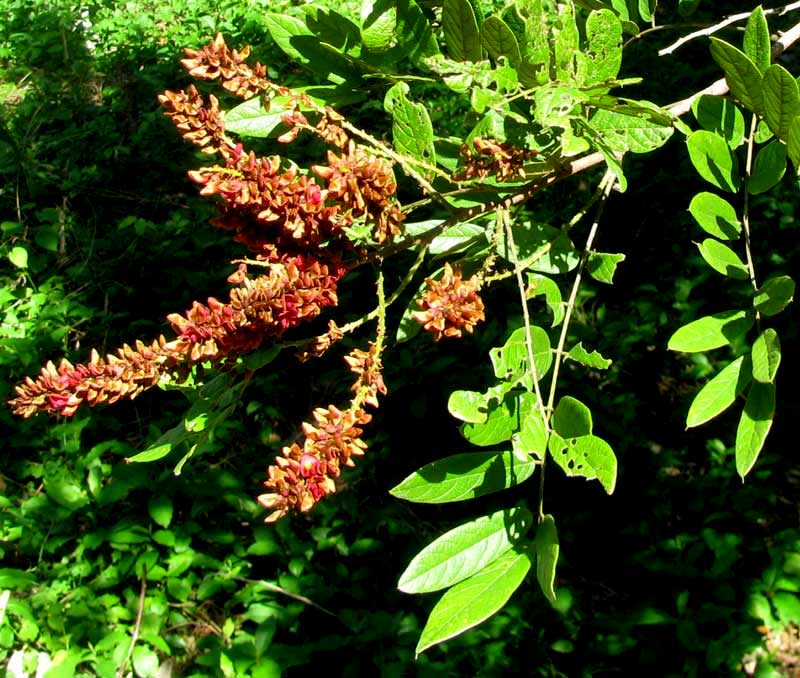
In mid-November I photographed our local native Balché species, LONCHOCARPUS RUGOSUS, at the peak of its flowering period. You can see its flowers and leaves above. A pinnately compound leaf from the tree is shown below:
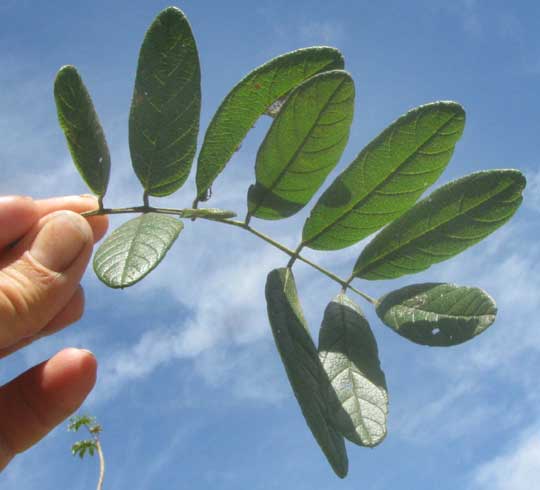
The leaves are similar to the North's ash tree leaves, except that Balché leaves arise singularly at each stem node. The species name "rugosus" derives from the technical term "rugose," which means "wrinkled." In the above photo you can see how leaflet surfaces are a bit sunken above veins, or "impressed." On the leaflets' undersides veins stand above the blade surface, which is densely and roughly hairy, as seen below:
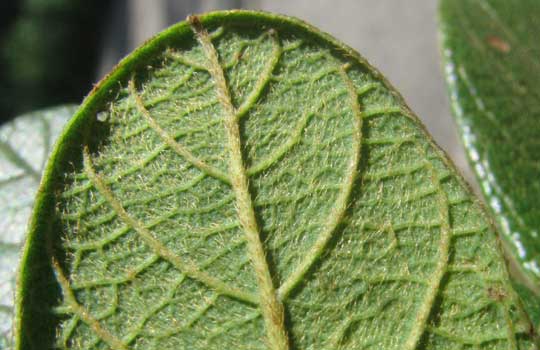
A close-up of some fully and partially open flowers is shown below:
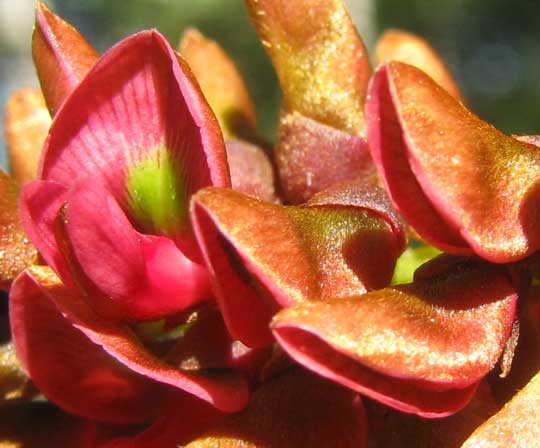
These are classic "papilionaceous" flowers typical of the Bean Family. Note the distinctive, rusty-colored hairiness on the backs of the top petals -- the "banners."
Nowadays our trees have discarded their abundant flowers, which carpet the ground like dry, brown confetti. The vast majority of flowers produce no fruits; usually only two or three fruits result in each flower spike. You can see some broad, thin fruits below:
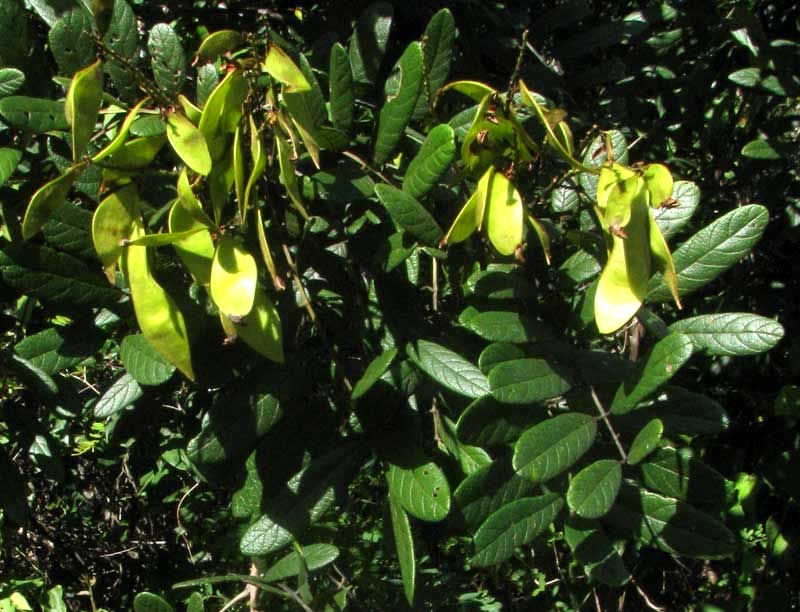
Often in gardens another Lonchocarpus species is planted. It's Lonchocarpus violaceus, introduced from the Lesser Antilles and Northern South America. You can see its larger flowers and smoother leaflets at www.backyardnature.net/yucatan/lonchoca.htm.
By the way, all the books I've seen use the spelling "balché," with the accented e indicating that "balché" is the Spanish rendering of the Maya word. That means that the word must be pronounced with the emphasis on the last, accented syllable. However, the shamans I know emphasize the first syllable, pronouncing it "BAL-che."
from the December 27, 2015 Newsletter issued from Hacienda Chichen Resort beside Chichén Itzá Ruins, central Yucatán, MÉXICO
BALCHÉ FRUITS MATURING
Nowadays Balché is producing nearly mature fruits, as shown below:
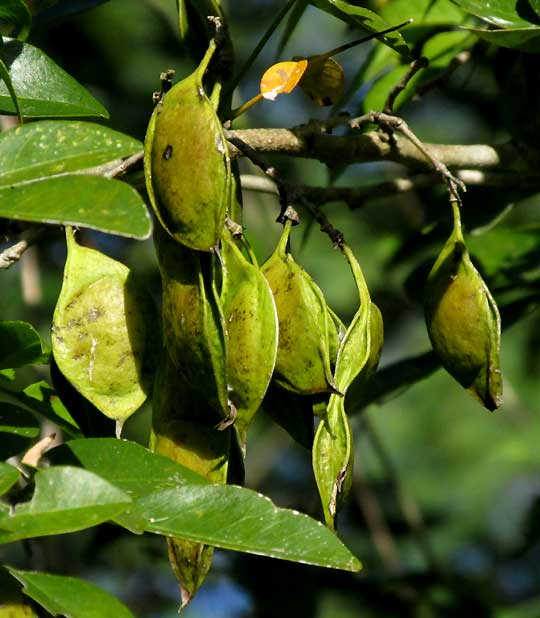
Since Balché is a member of the Bean Family, the fruits are legumes, and their seeds are beans. Balché legumes are unusual in that each bears only one or a very few beans. They're also noteworthy for each legume bearing on one side a kind of double ridge instead of just one sharp margin. Below, you can see two legumes exhibiting the legumes' two kinds of sides:
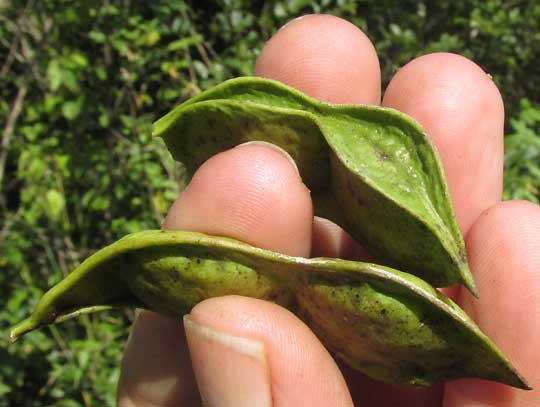
from the December 28, 2018 Newsletter issued from Rancho Regensis north of Valladolid, Yucatán, MÉXICO;
elevation ~40m (~130 ft), N~20.876°, W~88.170°
WHICH SPECIES IS THE "REAL" BALCHÉ?
Nowadays in north-central Yucatan Lonchocarpus rugosus is heavy with its legume-type fruits. This week I was talking with our Maya worker Juan, who is very knowledgeable about the traditional Maya names and uses of local plants, and he called our tree by another name. He said that the Balché tree was similar, but hardly ever seen in these parts.
I had no doubt about having seen Lonchocarpus rugosus used in Maya ceremonies, so on the Internet I spent most of a morning researching the matter. I found that the concepts of what the Balché tree is have changed a lot since I produced our Balché notes presented above. What follows is bound to be boring to anyone not curious about which species is the "real" Balché tree, but to a few folks it should be very interesting stuff.
In Suzanne Cook's 2016 masterpiece entitled " The Forest of the Lacandon Maya: An Ethnobotanical Guide," we learn which tree species the Lacandon Maya think of as Balché. The Lacandon perspective is important because these people, occupying part of the Chiapas lowlands across the river from Guatemala, in many ways retain more traditional Maya customs and learning than any other Maya group.
Suzanne Cook tells us that in Chiapas state twelve species of Lonchocarpus are listed, and several of those are known as Balché. In that group, the Lacandons recognize two kinds of Balché: Hach Balché, which means "authentic Balché," and: Ya'ax Balché, meaning "green Balché."
In Cook's work and in others the main "authentic Balché" appears to be Lonchocarpus longistylus, which occurs throughout most of the Yucatan but seems more common in the rainier eastern and southern parts. Our common species in north-central Yucatan, Lonchocarpus rugosus, is regarded as a "green Balché." Suzanne Cook writes that the two kinds of balché are "...differentiated on basis of leaf shape and color, flower color, bark texture, and degree of toxicity of resin in bark."
The Lacandon use species of "authentic Balché" in their rituals and say that "green Balché" species such as our Lonchocarpus rugosus may cause stomach aches and diarrhea. Since mostly I've seen the balché drink used in rituals during which it was poured as a sacrifice toward the four sacred directions, I'm guessing that our "green Balché," Lonchocarpus rugosus, was used because an "authentic Balché" couldn't be found locally. On the one occasion during which we drank balché, the shaman had brought his own balché brew from a different district.
In the Yucatan often we find the prettily flowering species Lonchocarpus violaceus planted as an ornamental. Our page for it is at www.backyardnature.net/yucatan/lonchoca.htm
On that page I point out that Lonchocarpus violaceus is native to the Lesser Antilles and northern South America, and not seen growing wild in our area.
With that in mind, finally in the often updated, authoritative Tropicos name database, I read that the name usually given for the main "authentic Balché," Lonchocarpus longistylus, and the name for our Lesser Antilles species, are now to be considered synonyms of Lonchocarpus punctatus.
In review, as of late 2018, my impression is that the main "real" Balché is considered to be Lonchocarpus punctatus, which until recently was called Lonchocarpus longistylus. However, our commonly occurring Lonchocarpus rugosus also is a Balché, and in our area, because Lonchocarpus punctatus is fairly uncommon, Lonchocarpus rugosus may be the most-used species in Maya ceremonies, at least in those in which the drink is not drunk.